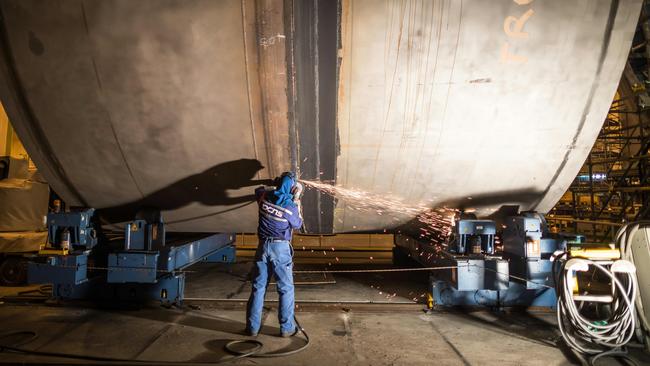
Our new submarines are under bizarre attack, the Collins subs have been officially rehabilitated and the future frigates have been assigned the most powerful missile defence systems in the world.
At a time when across the political divide in Australia, and across Asia, there are worries about whether Donald Trump represents a new unreliability in the US alliance system, we have never in peacetime more needed a powerful navy than now.
Our region is militarising. North Korea will soon be able to deliver nuclear payloads on intercontinental ballistic missiles. China is undertaking one of the biggest military build-ups in modern history. By 2030, one half of the world’s total submarines will be operating in our region.
Belatedly, but determinedly, and with seeming bipartisan support, we are now on a path to build the most formidable navy we have ever had in peacetime, and a navy that, for the first time in many decades, will give us a real self-defence capacity, a real strategic projection capacity, and which will also act as a massive force multiplier for the American alliance system in Asia.
The government announced this week that the nine future frigates, which we will start building in 2020, while still being configured for anti-submarine warfare, will all have the US Aegis Combat System, the world’s most advanced missile defence system.
They will join our three air warfare destroyers, which also have Aegis, giving us 12 surface combatants with the magnificent system of capabilities that the latest Aegis variant offers. These will join our two giant landing helicopter dock ships, which give us the ability to project force through the region in a multiplicity of ways.
And we will have 12 long-range, lethal submarines all with the AN/BYG-1 combat system, the best technology the mighty US Navy can produce.
The 12 Aegis surface ships and the 12 subs will all be built in Australia. That means they will cost more, but the Turnbull government, with the support of the Shorten opposition, is absolutely right to commit to building them in Australia.
This is for three compelling reasons.
One. If they don’t get built here, they won’t get built. This is a political reality. It is impossible to sustain upwards of $100 billion of naval expenditure across numerous political cycles if most of the money is going overseas.
Two. Building in Australia, if done properly, offers us the chance to create and sustain sovereign defence technology capacity of enormous benefit to us.
Three. The main reason building in Australia is so costly is because governments keep postponing or cancelling projects. That means every project undertaken in Australia is a virgin start-up. It is in the nature of all big, complex industrial projects that start-up costs are huge.
Whether he is your cup of tea or not, Defence Industry Minister Christopher Pyne is in the process of transforming our strategic outlook and industrial prospects. The government’s efforts to create a naval shipbuilding industry based on “continuous build” across destroyers, frigates, submarines, offshore patrol vessels and the rest, means the start-up costs are only borne once.
If we have the wit as a nation to sustain our commitment to this program across the political cycles we will get the navy we need, a formidable domestic industry and sovereign technological capacity.
Bill Shorten and Labor’s defence spokesman Richard Marles, are deeply committed to national security and understand that both sides of politics bear some blame for the long, slow, ludicrously delayed start to the program to replace the Collins subs. And they are certainly just as committed to Australian jobs as the government is. So there is a fair chance that this might actually work.
But our political culture contains many nutty elements that conspire against good policy, as the quite ludicrous attacks on our submarine project in recent weeks demonstrate.
The Government is committed to building 12 new subs with the French Naval Group, formerly DCNS. They will start to come into service in the early 2030s. To avoid a capability gap in the meantime, the Collins-class subs will have their service extended.
The government has not yet decided how many Collins subs it will extend and for how long. The extension actually holds out the possibility of Australia building towards 12 subs earlier than forecast because it is possible that six Collins boats could be operational as new subs come into service.
The decision on the French boat followed an exhaustive competitive evaluation process and extremely energetic and detailed bids from the Japanese and the Germans. American submariners and the most senior military people were involved in advising Canberra that the French were the best option.
At the time I backed the Japanese on strategic grounds but the French, in alliance with Australia, will certainly build very good subs. Australia already has hundreds of people at work on the project including more than a dozen permanently stationed in France. This will rise to 50-odd government people before Christmas and Naval Group Australia will send nearly 100 Australians to France by the middle of next year to spend two or three years on design and development work, and learning the French techniques.

If anything, the project is ahead of schedule, with the hull dimensions already decided in detail. But it is coming under truly eccentric fire from a range of weird sources. A group of activists who hate the French option funded a report by Insight Economics which opposes the project root and branch and offers loopy alternatives. This report is several thousand words of semi-coherent fantasy with endless figures conjured from magic.
It has had a good run from commentators who don’t know anything about defence. For example, it states that extending the Collins will cost $15bn. But the government has not yet determined how many Collins it will extend, nor for how long, so any such figure is nonsense.
The report proposes instead buying or building six short-range French Scorpene-class subs. Its strategic illiteracy is epic. Short-range subs, even modified, and long-range subs are inherently different. Two shorts does not make one long. They do entirely different things and carry different weapons. It proposes modifying these subs to give them longer range and then setting up a mother surface ship to look after them far to Australia’s north.
This is strategic analysis at the level of Biggles books for dullards. Such a ship would be a sitting duck. At any time of tension it would need to be withdrawn, so the short-range subs would lose their notional long range just when it was needed.
The report, while damning the new Naval Group subs, says we should nonetheless go ahead with them, but also build the modified six short-range subs, and buy the mother ship, for the miracle cost of less than $10bn.
The whole thing is absolute baloney from start to finish. Many of the things the report says about the Naval Group’s future subs are also wrong. It is perplexing that in any big Australian project there is always such a dedicated constituency for making it fail.
Equally absurd is the related campaign by some that we should get nuclear subs. The nuclear sub is the better sub but no nation runs nuclear subs without a domestic nuclear industry. There is not a snowflake’s chance in hell of any political party establishing a nuclear industry in the next decade. But any politician who talks airily about nuclear subs can have no credibility without establishing an Australian nuclear industry.
Then there is the argument that soon all subs will be obsolete so we shouldn’t bother with them at all. How is it that this revolutionary military insight has passed the Americans by, not to mention the Chinese, the Russians, the British, the Indians and everyone else who are is acquiring subs?
If any of these nutty objections gets any traction, they can only create further delay, so that instead of getting new subs early in the 2030s we wait until the 2040s or beyond, and kill all chance of a continuous build industry.
Surely we have moved beyond this stage of national insanity.
The frigates, meanwhile, are almost as sexy as the subs. They are a $35bn project. They will have two roles, anti-sub warfare and missile defence. No one is fonder of missile defence than me, but at this stage we are talking about the frigates defending themselves, and perhaps ships in an associated task group, from missiles fired at them by other navies or air forces.
However, by committing now to the Aegis Baseline 9 combat system we give ourselves the capacity to upgrade to full ballistic missile defence capabilities. Not only that, but all the ships’ radars will be able to communicate with each other and with allies in what is known as co-operative engagement capability. Having 12 such ships — the frigates and the AWDs — would give us all kinds of capabilities.
It would also give us the ability to join seamlessly and lethally with our US allies, and with their Asian allies, Japan and South Korea. We would all be formidable force multipliers for each other in any joint contingency.
The three frigate bidders are Britain’s BAE Systems, Spain’s Navantia and Italy’s Fincantieri. All three have serious strengths. The British build magnificent anti-sub ships. Protecting their nuclear subs and their aircraft carrier from hostile subs is core business for them. Navantia would use the same hulls as the AWDs; the firm and its Australian collaborators, have learned a great deal from the AWD experience. Fincantieri is a formidable bidder. Its ships would have two helicopters to attack subs — a big factor.
Anti-submarine ships use a great deal of submarine-style technology to be ultra-quiet. This can be things like covering the hull with smooth, silent tiles, or all the technologies subs use to keep internal noise down. The balance of technology between the sub and the surface ship is shifting. The sub still has the advantage but ASW ships are much more in the game than has been the case previously.
Australians love working with the British navy, the Spanish are a familiar partner and themselves operate Aegis systems, the Italians produce a superb ASW ship.
It may be that the definition of the role of these ships changed marginally this week. When Malcolm Turnbull talked of them in the context of North Korea, he seemed to add greater weight to their missile defence capabilities. The government is determined not to diminish their anti-sub capabilities, but we may get more vertical missile pods, and deeper pods that can take the more formidable missile interceptors.
Although even the best of these interceptors at the moment would be tasked with hitting shorter-range ballistic missiles, their eventual ability to intercept even ICBMs should not be ruled out.
Australia has embarked on something of the utmost importance and with a chance of delivering benefit to our nation across several critical dimensions: military capability, economic base, sovereign defence technology.
The subs, and even the frigates, will inevitably face challenges along the road. But you can’t complete the longest road if you never start. It would be a tragedy if our perennial culture of naysaying, or political short-termism, doomed these efforts just as they, all too belatedly, get going.




To join the conversation, please log in. Don't have an account? Register
Join the conversation, you are commenting as Logout